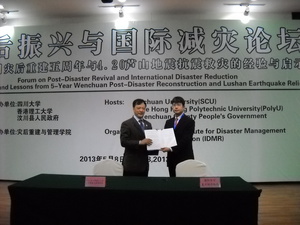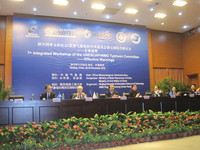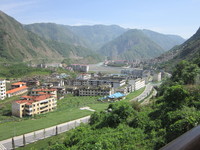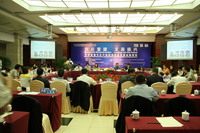Activity Report: Area & Country >> China
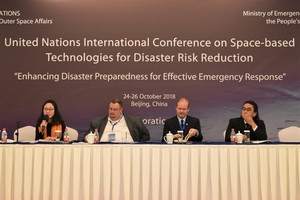
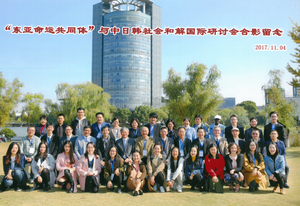
(1) This meeting is sponsored by budget regarding "One Belt, One Road" advocated by Mr. Xi Jinping, President of China;
(2) An idea of "Community of Shared Future (Word which translated Chinese '命运共同体' in English)" of the theme of meeting is an important pillar of Xi Jinping's idea;
(3) Although some worry recent Chinese diplomacy in East Asia as a threat, the present government attaches a great importance on the trilateral relationships in north-eastern Asia and will never become a threat for eastern Asia, as seen in the title of this meeting,
He stressed that, the present government successfully organized the 19th National People's Congress on October 24th prior to this meeting, has established a firm footing and ready to further improve the trilateral relationships in the future under the stable framework.
Session 1: "Constructing A Community of Shared Future in East Asia: Potentials and Challenges I"
Session 2: "Constructing A Community of Shared Future in East Asia: Potentials and Challenges II"
Session 3: "The Practice of Constructing a Community of Shared Future in East Asia I"
Session 4: "The Practice of Constructing a Community of Shared Future in East Asia II"
<2nd day, 5 November>
Liujiatang Village located on the riverside, has strived for improving water environment and promoted converting to flushing toilet in houses through early installation of septic tanks of combined treatment since the village has been designated as national environmental protection areas.
Yu Village has been revitalized to be an environmental conservation area by closing the mines and switching its industries to bicycle assembly and bamboo products. It is no exaggeration that these two villages are Xi Jinping's original sceneries, who was once the Secretary General of Communist Party in Zhejiang Provincial Government.
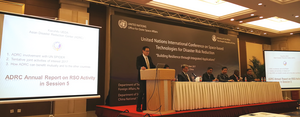 The 7th Annual UN-SPIDER Conference, jointly organized by the United Nations Office for Outer Space Affairs (UNOOSA) and the Ministry of Civil Affairs of the People's Republic of China, was held in Beijing on 23-25 October 2017. The event gathered almost 100 participants, including representatives of Space Agencies and Disaster Management Organizations from 34 countries and eight regions, who visited relevant organizations as a part of the three-days' program. ADRC representative attended the meeting from Day 2 afternoon, since the originally planned flight to Beijing on 22th canceled due to Typhoon.
The 7th Annual UN-SPIDER Conference, jointly organized by the United Nations Office for Outer Space Affairs (UNOOSA) and the Ministry of Civil Affairs of the People's Republic of China, was held in Beijing on 23-25 October 2017. The event gathered almost 100 participants, including representatives of Space Agencies and Disaster Management Organizations from 34 countries and eight regions, who visited relevant organizations as a part of the three-days' program. ADRC representative attended the meeting from Day 2 afternoon, since the originally planned flight to Beijing on 22th canceled due to Typhoon.The theme of session 3 from afternoon on Day 2 was "Technology integrated for disaster risk assessment and emergency response". Each participant reported their activities including Food and Agriculture Organization of the United Nations (FAO), Beijing Normal University, "Continuum Planning and Development Trust, India" a Non-Profit Organization, and Ministry of Home Affairs, India. Amongst all, in the report of FAO, they proposed indicators influencing decision making for food aid by focusing on assessment of situation within seventy-two (72) hours after disaster occurrence, by learning from the cases of "Cyclone Pam" (Vanuatu, March 6, 2015) and "The Great Southern Asia Flood" (Bangladesh, August-September / Sri-Lank May / Nepal, August, 2017).
ADRC joined the session entitled "Integrated emergency response tools/systems" among the parallel session after break. In this session, World Vision International, Department of Civil Protection, Zimbabwe, and National Institute of Aeronautics and Space, Indonesia (Lembaga Penerbangan dan Antariksa Nasional - LAPAN) provided their reports. LAPAN reported about landslides that hit Banjarnegara, Central Java every year and expressed their appreciation for the contribution of Sentinel Asia in the presentation.
<25th October>
On the final day of the conference, plenary session 4 and 5 took place in the morning and site visits in the afternoon.
The session 4 discussed "Integrated applications of earth observation, global navigation satellite system and telecommunication constellations for disaster risk reduction and climate change related extreme hazards" and Newcastle University (England), Beijing University (China), and Delta University (USA) provided their reports.
The report of Newcastle University was about the analysis of landslide by Interferometric SAR in Xinmo village, Mao counter, Ngawa Tibetan and Qiang Autonomous Prefecture, Sichuan Province, China, while Beijing University reported about the analysis of the affected areas by the Kumamoto Earthquakes by using Polarimetric SAR in (ALOS PALSAR PolSAR, April 21, 2016). Both reports emphasized the expectation for further use of Synthetic Aperture Radar (SAR) satellite for emergency response, enabling assessment of affected situation easier.
In the afternoon, participants were divided into two groups, one visited the National Disaster Reduction Center of China, and another, China Academy of Space Technology (CAST) Exhibition Center. ADRC representative joined the former.
ADRC visited the Institute of Geology, China Earthquake Administration (CEA) to make an interview about Emergency Observation Request (EOR) for Jiuzhaigou Earthquake in August this year.
19-22 September 2016 (Beijing, China)
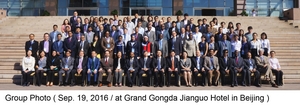 The 6th Annual UN-SPIDER Conference, jointly organized by the United Nations Office for Outer Space Affairs (UNOOSA) and the Ministry of Civil Affairs of the People's Republic of China, was held in Beijing on 19-21 September 2016. The event gathered about 130 participants, including representatives of Space Agencies and Disaster Management Organizations from 35 countries, who visited relevant organizations as part of the three-day program.
The 6th Annual UN-SPIDER Conference, jointly organized by the United Nations Office for Outer Space Affairs (UNOOSA) and the Ministry of Civil Affairs of the People's Republic of China, was held in Beijing on 19-21 September 2016. The event gathered about 130 participants, including representatives of Space Agencies and Disaster Management Organizations from 35 countries, who visited relevant organizations as part of the three-day program.
<First Day: 19th September>
The key officials at the inauguration included: Mr. Benjie Yin (Deputy Director, General Office of China National Commission on Disaster Reduction) who delivered the opening remarks; Ms. Mei Chai (Deputy Director-General, Department of International Cooperation, Ministry of Civil Affairs) who served as moderator; and Dr. Shirish Ravan (Secretary-General, UN-SPIDER Beijing Office) who provided an overview of sessions to be covered in the three-day program.
The sessions of the first day were "Building on UN-SPIDER 10 Years' Achievements" and "Risk Assessment and Mapping Using Earth Observation Data". There was presentation prior to each of these topics' discussions. In second session for instance, the value of radar sensing on satellite technology was highly evaluated, and the accuracy of drought prediction was discussed, which needs to be improved through observation and data accumulation.
<Second Day: 20th September>
The morning sessions of the second day were "Access to Data and Information for Risk Assessment" and "National Spatial Data Infrastructure and Data Framework to Support Disaster Management". The morning sessions highlighted the contribution of satellite data for flood and drought monitoring and prediction. Hence, initiatives such as the introduction of "GAOFEN", with series of high resolution earth observation satellite system in China, needs to be effectively promoted.
In the afternoon, three breakout sessions were organized, namely: "Monitoring indicators against the global targets of the Sendai Framework", "Procedural guidelines for sharing space-based information during emergency response", and "Crowd-source Mapping for risk assessment and emergency response". ADRC representative participated in the second breakout session, and reported the importance of proactive participation in learning events and capacity building enhancement in each country to facilitate sharing of space-based information.
<Third Day: 21th September>
The morning session of the third day was about "Networking and Engagement with the UN-SPIDER Network", where reports from Regional Support Offices (RSOs), including ADRC, as well as country reports were presented. In the afternoon, two separate site visits were organized - one group visiting the National Disaster Reduction Center of China (NDRCC) and the other group visiting the Yungang Satellite Earth Station. ADRC representative joined the first group that also visited the UN-SPIDER Beijing Office.
After the conference, the ADRC representative took the opportunity to visit his colleague of the NDRCC in the morning (9:30 - 11:00) of following day to discuss further strengthening of ADRC-NDRCC cooperation. She is the former ADRC Visiting Researcher(FY 2007) and is currently Director of Data Center, Satellite Application Center for Disaster Reduction at NDRCC.
In the afternoon (12:30 - 14:00) of the same day, a visit to the Executive Director of the Integrated Research on Disaster Risk (IRDR) was also made to explore ways for collaboration and cooperation in improving collection of information.
Participation in this conference has helped to strengthen ADRC organizational networks with relevant countries and organizations as well as build wider human relations.
(2016/09/23 19:30)
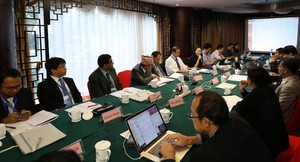
The 8th Senior Disaster Management Officials Forum (SDMOF), was held on August 11-12, 2014, Beijing, China.
Representatives and experts from APEC economies and international agencies gathered for this forum (APEC-funded project led by China) under the theme: 'Science and technology strengthening disaster risk reduction,'
Participants shared experiences and best practices under following topics: Innovative role of science and technology in disaster preparedness; Science and technology strengthens efficiency in emergency response; Science and technology enables rehabilitation for increased resiliency; and International and regional cooperation on science and technology application for disaster risk reduction.
8-11 May 2013 (Chengdu, China)
The Forum on Post-Disaster Revival and International Disaster Reduction -Experience and Lessons from 5-Year Wenchuan Post-Disaster Reconstruction and Lushan Earthquake Relief, organized by the Sichuan University, and the Hong Kong Polytechnic University, was held in Chengdu, China in May 2013. As a cooperation of this forum, the ADRC sent one representative from IRP secretariat to attend. The forum's over 300 participants included experts from government officials and academic experts across China.
During the keynote speech, Mr. Shingo Kouchi, ADRC Senior Expert as well as IRP Senior Recovery Expert, valued the Government and people of China's high ability to promote recovery and reconstruction efforts following the Wenchuan Earthquake that struck Sichuan Province in May 2008. Mr. Kouchi also noted that ADRC and IRP have long been in help to China's efforts to utilize Japanese technologies, experiences, and lessons related to earthquake disaster risk reduction.
Mr. Kouchi also emphasized the importance of everyday preparedness by citizens, in addition to the government efforts, when a massive disaster strikes. In this connection, the Lushan Earthquake which occurred in late April showed the evidence of progress of disaster reduction and preparedness since five years ago.
On occasion of commemorating the fifth anniversary of the Wenchuan earthquake, the Sichuan
U - The HK PolyU Institute for Disaster Management and Reconstruction (IDMR) has been established. Followed by the opening ceremony, signing ceremony of MoU between ADRC and IDMR was held. The purpose of ADRC and IDMR is to promote smoothly the releasing and sharing of information related to disaster prevention and post-disaster reconstruction, developing of disaster prevention and post-disaster reconstruction programs and educating talents in the field of disaster prevention and post-disaster reconstruction. The two parties will be dedicated to cooperation and mutual participation in the following activities;
(1) Promote personnel exchanges by mutual reception of research staff, faculty and students related to activities of both parties.
(2) Give priority to research projects with mutual participation to promote collaborative research.
(3) Promote the implementation of joint activities including the releasing and sharing of information on research results and professional knowledge.
The ADRC, together with the IDMR, would like to continue to support efforts to strengthen the disaster reduction capabilities of the affected communities.
(2013/06/11 14:50)
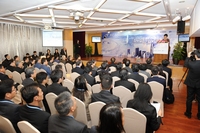
The Asian Disaster Reduction Center (ADRC), participated in the 45th Session of the Typhoon Committee which was jointly organized by the United Nations Economic and Social Commission for Asia and the Pacific (UNESCAP), the World Meteorological Organization (WMO) Typhoon Committee Secretariat, the Hong Kong Observatory in Hong Kong on 27-29 January 2013. The more than 100 participants who attended the meeting included representatives from Cambodia, China, Japan, Lao, Malaysia, Philippines, Republic of Korea, Thailand, US, Viet Nam, and the Macao Special Administrative Regions, as well as representatives of the organizing institutions. The participants discussed action plan of this committee in next fiscal year as well as their countries' activities in this fiscal year.
The Typhoon Committee has three working groups on meteorology, hydrology and disaster risk reduction (DRR). The DRR group which ADRC participated reported the SSOP (Synergized Standard Operating Procedures for Coastal Multi-Hazards Early Warning System) project in this session. This project, in which ADRC plans to participate, will be carried out in earnest from next fiscal year.
For more information, visit
http://www.typhooncommittee.org/45th/index.html
(2013/1/27 19:40)
26-27 November 2012 (Nanjing, CHINA)
ADRC participated in the 7th Integrated Workshop of the Typhoon Committee which was jointly organized by the United Nations Economic and Social Commission for Asia and the Pacific (UNESCAP), the World Meteorological Organization (WMO) Typhoon Committee Secretariat, the China Meteorological Administration (CMA), and Nanjing University of Information Science & Technology (NUIST) in Nanjing on 26-27 November 2012. The more than 100 participants who attended the meeting included representatives from Japan, Lao, Malaysia, Philippines, Republic of Korea, Thailand, US, Viet Nam, Hong Kong and the Macao Special Administrative Regions, as well as representatives of the organizing institutions. The participants discussed their approaches to issuing "effective warnings," which was the main theme of the meeting. For the Disaster Risk Reduction Working Group, Japan's Cabinet Office gave a presentation on the damage caused by typhoons in 2012 and on ADRC activities such as the Visiting Researcher Program.
The Typhoon Committee has two other working groups on meteorology and hydrology, in addition to the working group on disaster risk reduction. This workshop brought the three working groups together for an integrated meeting.
For more information, visit
http://www.typhooncommittee.org/IWS_Nanjing/index.html
(2012/11/30 19:40)
14-16 May, 2012 (Sichuan Province, China)
The Forum on "Successful Reconstruction - Looking into the Future - A Discussion on Disaster Reconstruction and Development Strategy in the Beichuan Earthquake Ruin Area" was organized by Sichuan University and IRP/ADRC on 14th May in Chengdu, Sichuan. It was almost 4 years after the Sichuan Earthquake(12th May 2008). More than 50 delegates from abroad, government and academe participated in the forum and had a fruitful discussion on the post disaster recovery issues including establishment of new Beichuan Earthquake Museum and mechanism for promoting international cooperation based on the lessons from the Sichuan Earthquake.
After the forum, the IRP/ADRC team visited disaster affected sites to understand the recovery process during the past 4 years. In particular, the team visited (i) the Beichuan Earthquake Museum construction site, (ii) Shiyi village located in a high mountainous area of Qiang autonomous region, (iii) Jina village, which is famous for its ethnic style reconstruction houses, (iv) New Beichuan Town, which is a relocation case from disaster affected old town, and (v) other towns and villages.
Based on the findings from the field survey and interviews, IRP/ADRC will compile a report on good practices on recovery from the Earthquake.
31 Oct - 2 Nov 2011 (Beijing, China)
27-28 October 2011 (Shanghai, China)
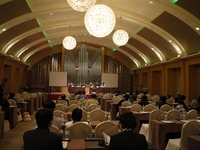
The Shanghai Forum on Disaster Prevention, Post-Disaster Reconstruction and International Cooperation: Learning from both Japanese and Chinese Experiences was organized by Osaka University from 27 to 28 October 2011 at Hotel Nikko in Shanghai, China.
The forum was attended by researchers from Japanese and Chinese universities as well as experts from international organizations. Invited by Osaka University, IRP/ADRC also participated in the Forum.
The Forum addressed: a) The role of civil society and social capital on post-disaster reconstruction and disaster prevention; b) Advanced technologies to reduce earthquake damage of structures; c) Earthquake damage and countermeasures of civil engineering structures; d) Disaster assistance network across the border; e) Nuclear energy: Safety, risk and human resources education, including a panel discussion on disaster prevention, post-disaster reconstruction and international cooperation.
IRP/ADRC presented the significance of social capital in disaster reduction and recovery based on the analysis of community-level recovery cases throughout the world. The presentation drew a lot of attention from both Japanese and Chinese researchers.
(2011/11/15 14:00)
18 October -21 October 2011 (Beijing, China)
ADRC participated in the Seminar on East-Asia Earthquakes Studies - Earthquakes, Tsunamis and Volcanoes in Northeast Asia: International Collaboration and Regional Capacity Building for the Forecast, Preparedness and Early Warning.
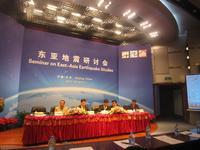 The Seminar was organized jointly by the China Earthquake Administration (CEA), the Japan Meteorological Agency (JMA), and the Korea Meteorological Administration (KMA). It was a first attempt of this kind.
The Seminar was organized jointly by the China Earthquake Administration (CEA), the Japan Meteorological Agency (JMA), and the Korea Meteorological Administration (KMA). It was a first attempt of this kind.
The Seminar addressed key scientific and technological issues in need of special consideration for forecast, preparedness and early-warning of earthquakes, volcanoes and tsunamis, especially for Northeast Asia. Experts from not only China, Korea and Japan but also from other countries in Asia and other regions participated and examined relevant issues based on their experiences, most notably the 2008 Wenchuan Earthquake in China and the 2011 Great East Japan Earthquake and Tsunami.. Mr. Atsushi Koresawa of the ADRC presented "Policy Response to Great East Japan Earthquake" in the "Communicating with the Public" session.
The Seminar was successfully closed by reaching a consensus that collaborate need to be continued and strengthened among China, Korea and Japan and with other countries in Asia to further enhance scientific knowledge and relevant technologies against seismic hazards.
(2011/10/22 13:10)
22-23 September 2010 (Chengdu, China)
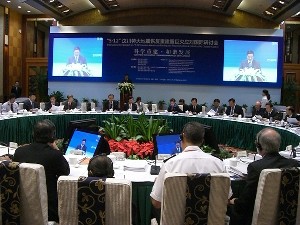
The International Symposium "5.12 Massive Wenchuan Earthquake Reconstruction & Catastrophic Disaster Control" was held in Chengdu, China on 22 and 23 September 2010. The event was jointly organized by the Provincial People's Governments of Sichuan, Shanx, and Gansu and the Chinese Academy of Governance. Mr. Onishi, Senior Administrative Manager of Asian Disaster Reduction Center (ADRC) was invited to participate.
Around 130 representatives from international organizations, national and local governments, and experts from 30 countries and organizations in America, Europe, and Asia attended the symposium. On day 1, the participants visited the reconstruction sites in Yingxiu town, Shuimo town, and Dujiangyan city to look at the progress of recovery. On day 2, presentations concerning the theme "Scientific Reconstruction and Harmonious Development" were made. The title of Mr. Onishi's presentation is "From Resilient Recovery to Sustainable Development: Development of Recovery and Rehabilitation Measures".
(2010/09/22 19:20)
28-30 October 2009 (Beijing, China)
The International Conference on the Social Mobilization for Catastrophic Disasters and the Formulation of Emergency Laws and Regulations was organized by the Ministry of Civil Affairs of China, was held on 28-30 October 2009 in Beijing, China. Mr. Fujieda, senior researcher of the ADRC was invited to participate in the conference.
Around 130 representatives from international organizations, ASEAN member countries, UK, USA, Canada, Australia, New Zealand, as well as Chinese government, regional institutions, NGOs, participated in the Conference.
The participants from different countries made presentations on the role of the government in the catastrophe emergency response, developments in the laws and regulations on disaster management and disaster-relief activities from their own perspectives. On the other hand, the participants from China including government, NGOs and other institutions, made presentations on roles of volunteers, communities and enterprises in relief activities in the case of Whenchuan Earthquake.
Mr. Fujieda made presentation on disaster management laws and systems and disaster emergency response system in Japan in the session titled "the Role of Government in Social Mobilization on Catastrophic Disasters and Laws and Regulation Development".
(2009/10/28 17:30)
28-29 May 2009 (Chengdu, China)
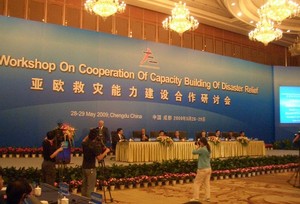
ASEM (Asia-Europe Meeting) Workshop on Cooperation of Capacity Building of Disaster Relief, organized by the Ministry of Civil Affairs and the Ministry of Foreign Affairs of China, was held on 28-29 May in Chengdu, China.
In the opening ceremony speech, Mr. Li Xueju, Minister of Civil Affairs of China noted that Europe and Asia should reinforce the exchanges of knowledge and experience and cooperation in disaster reduction and relief. Asian countries have rich experience in disaster relief, while the European countries possess advanced technology and management concepts. Both sides should overcome their own shortcomings by learning from each other's strong points.
Total of 160 representatives from 32 member countries of the Asia-Europe Meeting and international organizations are present at the workshop.
The workshop focused on four core thematic areas: (1) disaster preparedness and emergency relief; (2) rehabilitation and reconstruction; (3) public-private partnership in disaster relief; and (4) disaster reduction and risk management. ADRC made a presentation entitled "Build Back Better" to introduce the activities of its own and IRP(International Recovery Platform).
Participants also visited the earthquake-affected areas in Dujianyan, Sichuan Province.
(2009/06/05 19:20)
7-9 April 2009 (Chengdu, China)
The International Forum on Recovery and Reconstruction of Yingxiu, organized by Sichuan Provincial Construction Department, Guangdong Provincial Construction Department, Government of Aba Prefecture and China Academy of Building Research, was held in Chengdu, China, from 7 to 9 April, 2009. Three participants, headed by Mr. Suzuki, Executive Directive, from Asian Disaster Reduction Center (ADRC), one of the co-organizer, attended the forum. Please refer the file below for the detail.
Forum_Report_e.pdf
(2009/05/12 17:30)
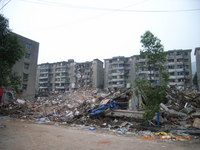
The Asian Disaster Reduction Center (ADRC), in cooperation with the Disaster Reduction and Human Renovation Institution (DRI), investigated ways for the lessons and experiences of the Great Hanshin-Awaji Earthquake with regard to recovery and restoration of disaster-stricken areas to be utilized in response to the Sichuan Province Earthquake that struck Wenchuan County in China's Sichuan Province (GLIDE no. EQ-2008-000062-CHN) on 12 May 2008. To conduct this investigation, ADRC Senior Researchers spent 25-30 May visiting the cities of Dujiangyan and Mianzhu in the disaster-stricken area to assess the situation on the ground and to share nformation with officials from the Sichuan Provincial People's Government, the China Earthquake Administration, and the National Disaster Reduction Center (NDRC) of the Ministry of Civil Affairs.
Further information, please refer to : http://www.adrc.asia/highlights/NewsNo183
(2008/06/03 20:00)


